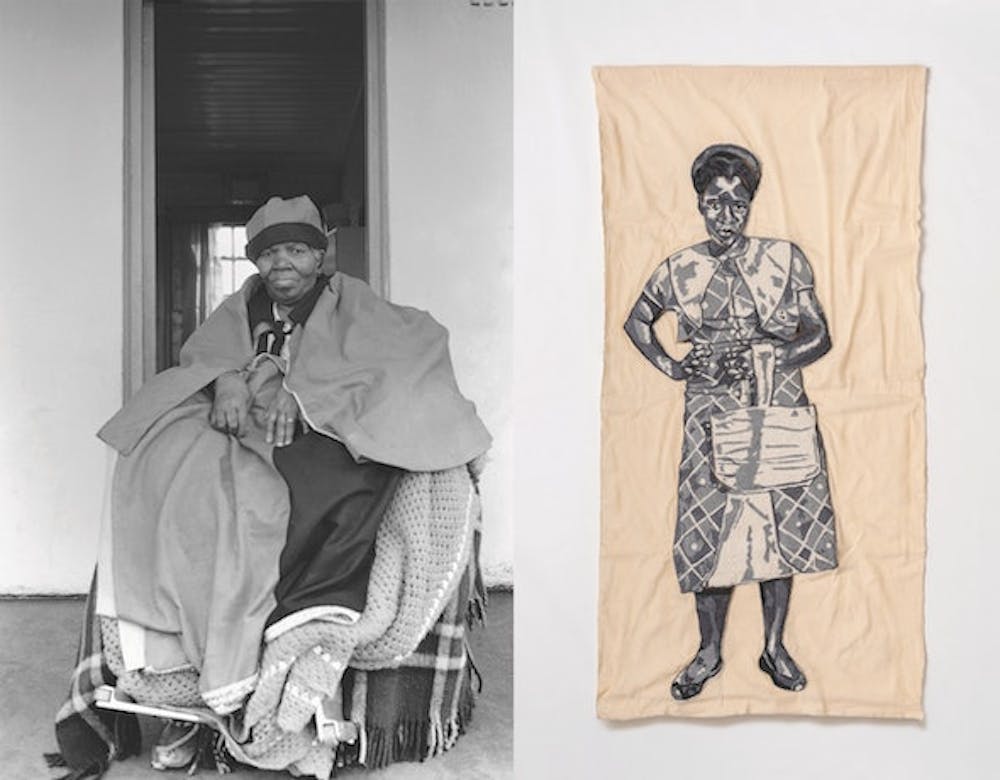On visits to the Barnes Foundation, I usually have the same expectations in mind. I’ll see Renoir’s pale naked ladies, Degas’s French dancers, and piece after piece by other white Impressionists. I’ll take in every hazy, pastel–colored world, locked in gold frames, chosen by Dr. Barnes himself.
And although I love each inch of the Barnes’ permanent collection, my latest visit was a pleasant change from what I see as the stereotype of the museum. A new exhibition, Tell Me What You Remember, on view until May 21, by two acclaimed South African artists, follows history, memory, and narration in the context of Apartheid and its legacies.
The two artists, Sue Williamson and Lebohang Kganye, reflect on this in different ways. Sue Williamson, born in 1941, is part of a generation of artists who felt a responsibility to use their work to address the struggle of apartheid. After she attended the multiracial Women’s Movement for Peace in 1976, she became an activist—a role that is woven through her work. Since the 80s, she has been documenting history she feels is at risk of being forgotten or replaced.
Lebohang Kganye was born in South Africa in 1990. In 2010, after the death of her mother, Kganye traveled across the country, collecting stories of her family's experiences that inform and propel her work. Unlike Williamson, her only firsthand memories of Apartheid come from oral histories. She investigates how her family’s history intersects with South Africa’s political past and present.
These experiences are shown through each woman’s work. As I enter the main room of the exhibition, three large cloth portraits look down at me. Here, Kganye memorializes the women of her family in larger–than–life, hand–stitched, black–and–white tapestries entitled Mosebetsi wa Dirithi. The inspiration for these portraits was derived from photo albums and stories from her grandmother. The women depicted on the cloth are Kganye’s grandmother, great–grandmother, and cousin, whom she has only met through stories. Here, memory and storytelling permeate each stitch of her work, immortalizing each woman with a halo of gold cloth surrounding them.
A series of photographs by Williamson, aptly named All Our Mothers, accompanies the tapestries. They are portraits of women who were integral to the liberation movement and resisted apartheid and its aftermath. Kganye’s female relatives and the revolutionary women Williamson documents exist together in one space. Conversations between the two artists’ works, such as this one, are prevalent throughout the whole exhibit.
In the next room lives Williamson’s Memory Work. After South Africa’s first democratic election in 1994, she shifted her focus to the role of memory, which is what legal apartheid was becoming. Memory Work is a collection that includes video interviews, drawings, testimonies, and Truth Games, which immortalizes high–profile crimes investigated by the Truth and Reconciliation Commission, which held hearings from 1996 to 1998 on apartheid–era crimes.
Accompanying Memory Work is Kganye’s In Search for Memory. The collection includes diagrams of photographs that stage memories, a video of the artist recreating her grandfather’s journey while wearing his suit, and a series of photographs in which she dresses as her mother. Kganye inserts herself into old photographs of her mother, becoming her semi–transparent shadow, echo, and ghostly twin.
In the next room, through large–scale photographs of family and landscapes that make dioramas, Kganye maps the origins of her family name, which comes from the word Kganya, or light. Four scenes represent the four spellings, and a large light in the middle illuminates the whole space, tying the scenes and the name’s etymology together.
Through linking memories across time, the drawings, stitchings, photographs, diagrams, and video installations by each artist make viewers reckon with the legacy of apartheid and colonialism, and how they choose to remember it. These works also represent a country, history, medium, and movement that is largely missing from the permanent collection of the Barnes. Until now.

